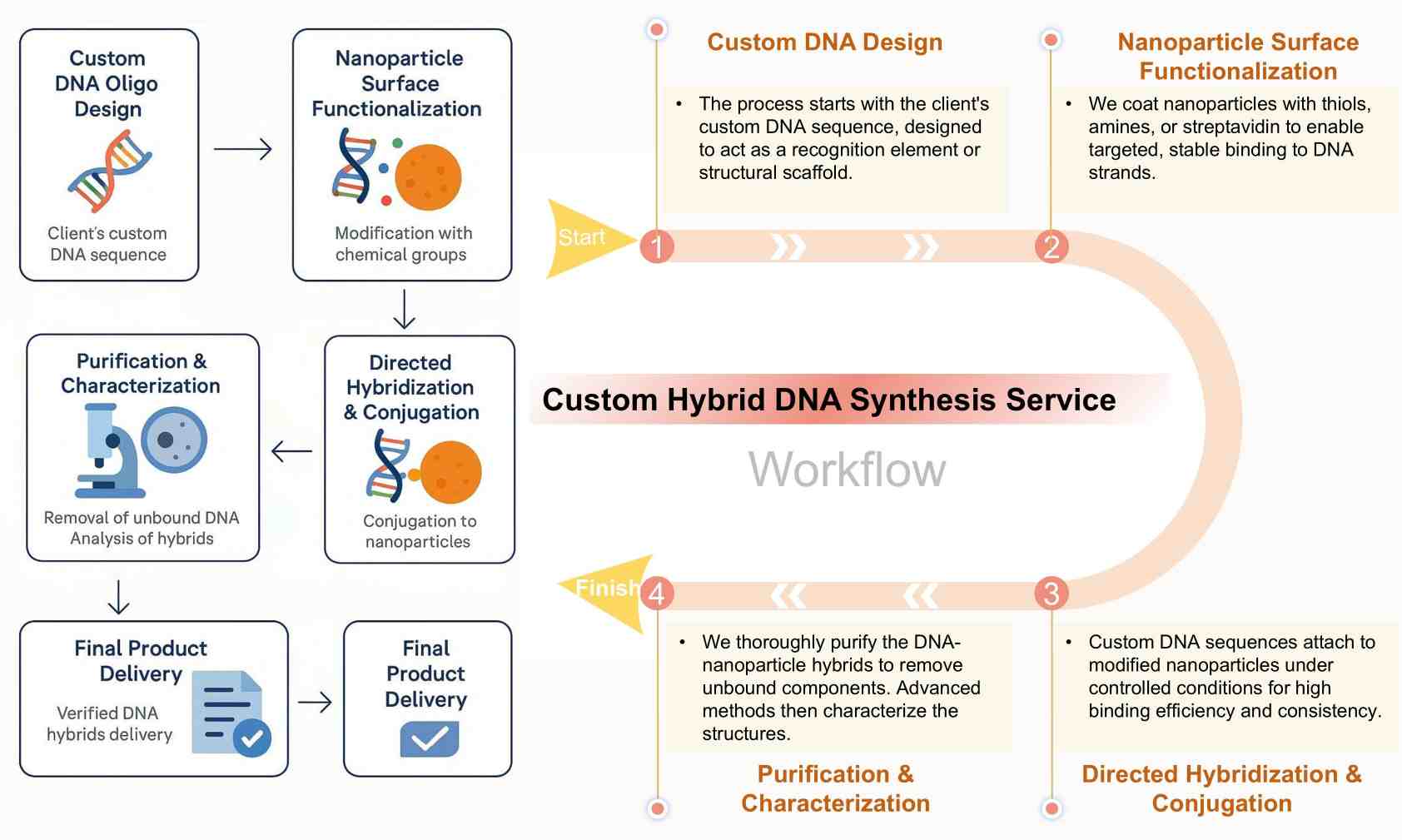



DNA, which contains repetitive functional residues, acts as the genetic code for the survival of all living beings on the earth. It has gradually been recognized as a polymeric nanostructure. Nucleic acid nanotechnology aims to create nanoscale objects, materials, and devices by folding and combining DNA or RNA components. DNA nanotechnology is useful in many areas, including fundamental biology, academic and industrial fields. With the rapid advancement of structural transformations, structural DNAs have been assembled into various forms, such as X- or Y-shaped DNAs.
Due to their unique characteristics, such as superior electromagnetics and inherent biocompatibility, inorganic nanomaterials have long been used for biological purposes. To use them within the cytosol, it is necessary to reduce their size. Using structural DNA nanomaterials has significantly improved the ability to employ inorganic compounds.
Our service is founded on the principle of directed self-assembly, where custom-synthesized DNA oligonucleotides are meticulously conjugated to nanoparticles to create functional hybrid structures. This process leverages the inherent base-pairing properties of DNA to direct the precise spatial arrangement of the nanomaterials. We employ specialized surface chemistries and linkers to ensure stable and covalent attachment of DNA strands to the nanoparticle surface. This allows for the creation of robust and highly specific DNA-nanomaterial conjugates with predictable architectures, enabling diverse applications that demand high precision and reliability. Our approach ensures a uniform, high-quality product ready for immediate use.
Hybrid materials made of structural DNAs and inorganic compounds show significant progress in various cutting-edge applications, including biological uses. Therefore, CD BioGlyco has developed various technologies for the synthesis of various hybrid materials made of structural DNAs and inorganics. Those hybrids have potential as future material substitutes for some practical bio-applications.
DNA-gold nanomaterial hybrid
Agarose gel is utilized to purify the hybrids. We employ a freeze-squeeze column technique to slice and extract the target products from the gel. The transmission electron microscope (TEM) and the ultraviolet-visible (UV-vis) spectrometer are utilized for the characterization of the purified nanostructures.
DNA-magnetic nanoparticle hybrid
Iron oxide nanoparticles have gained significant attention in various practical applications due to their super-paramagnetism in magnetic fields. We offer an approach for arraying magnetic nanoparticles on the surface of DNA nanotubes. The positioning of magnetic nanoparticles on the outer surface of DNA nanotubes is achieved through the self-assembly of polynucleotide staples using an origami process. To arrange the staples on the surface of DNA nanotubes, we use a biotin labeling technique to selectively label some of the staples.
These hybrids have the potential to arrange multiple nanoparticles. They are valuable as functionalized chimeric nanocarriers for the development of innovative nanodrugs and nano biosensors.
DNA-silver nanomaterial hybrid
Compared to gold nanoparticles of the same size, silver nanoparticles exhibit higher extinction coefficients. They are more suitable for plasmonic applications such as enhanced Raman scattering. Conversely, silver nanoparticles have lower Ag-S bond energy compared to Au-S, making it more challenging to conjugate them with monothiol-modified DNA. Additionally, silver nanoparticles are more susceptible to oxidation in nanoparticle form and have a tendency toward irreversible aggregation. We link monothiol-modified DNA to silver nanoparticles which surmounts problems associated with adsorption kinetics at neutral or slightly basic pH. DNA-silver nanomaterial hybrid can be used in DNA detection through sandwich assays and electrochemical detection methods.
The process begins with the client's custom DNA sequence, which is designed to function as a specific recognition element and/or a structural scaffold.
We prepare the desired nanoparticles by modifying their surfaces with specific chemical groups, such as thiols, amines, or streptavidin, to allow for stable and directed coupling with the DNA oligonucleotides.
The custom DNA sequences are then conjugated to the functionalized nanoparticles under controlled conditions, ensuring a high degree of binding efficiency and uniformity. For example, a biotinylated oligonucleotide probe can be conjugated with streptavidin-modified nanoparticles.
The resulting DNA-nanomaterial hybrids are rigorously purified to remove any unbound DNA or nanoparticles. We then use a range of advanced analytical techniques, including transmission electron microscopy (TEM) and complex magnetization measurements, to characterize the hybrid structures, confirming their size, morphology, and conjugation efficiency.
The verified and quality-controlled DNA hybrids are delivered to the client, accompanied by a comprehensive technical report detailing the synthesis parameters and characterization data.

DOI.: 10.1186/s40580-019-0211-4
Journal: Nano Convergence
IF: 11.0
Published: 2020
Results: This panoramic critique examines conjugations of architectured DNA nanotechnology with inorganic species, including gold, iron oxide, quantum dots, upconversion nanoparticles, and carbon nanotubes, forging hybrid constructs for sophisticated biomedicine. They dissect how nucleic acid frameworks such as multi-arm junctions, folded lattices, and hollow cylinders act as programmable molecular pegboards that orchestrate inorganic components with Ångström-level precision to elicit cooperative functional augmentations. Paramount implementations encompass precision pharmacotherapy delivery, plasmonic hyperthermia treatments, high-definition biomolecular visualization - particularly NIR-II spectral tomography using nanotubular carbon - alongside affinity biosensors. These chimeric systems exploit DNA's innate biological tolerability while mitigating constituent frailties, namely quantum dot photodegradation and tissue-penetration depth constraints. Landmark innovations, including optoacoustic contrast agents and stimulus-actuated therapeutic nanoassemblies, are foregrounded, with concomitant emphasis on uncharted diagnostic and interventional potentialities within pathological contexts.
We deliver high-fidelity, complex DNA constructs for gene editing and synthetic biology applications. To maximize the functional adaptability of these sequences, enabling precise conjugation, labeling, or immobilization, we offer Oligonucleotide-based Linker Modification Services. These targeted modifications engineer site-specific handles for downstream integration:
CD BioGlyco is a highly topping company in the field of glycobiology. We are widely recognized for exceptional proficiency in Custom DNA Synthesis Service. Our company is confident in our extensive knowledge in this field. With an experienced team, we offer a comprehensive range of services to meet the unique requirements of our clients. If you would like to know more about our services, please feel free to contact us for further information.
Reference
